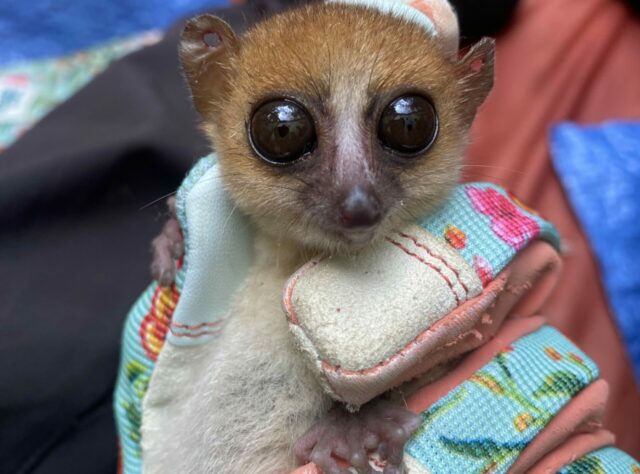
One of the lemurs studied by Dr. Marina Blanco at the Ankarabolava-Agnakatrika forest. Provisional results from genetic analysis suggest that it is an Anosy Mouse Lemur. Credit: Marina Blanco
The Ankarabolava-Agnakatrika forests of southeastern Madagascar are an important refuge for dwarf and mouse lemurs. But, for some time, our partner MBG-Madagascar has not known which ones. Now, with the help of lemur expert Dr. Marina Blanco, they are starting to find out.
In October 2023, Dr. Marina Blanco – one of the world’s top lemur researchers – arrived at the Ankarabolava-Agnakatrika Forest Protected Area for a 2-weeklong fieldtrip. The lush rainforest here is the last remaining forested area in the Vangaindrano District, home to at least 50 threatened animal and plant species, including the Critically Endangered White-collared Lemur (Eulemur cinereiceps).
But Marina’s passion is for Madagascar’s smallest – and arguably cutest – lemurs: the dwarf and mouse lemurs. We currently know of around 35 species of dwarf and mouse lemur. All of them are only active at night and all are quite tiny – the smallest, the Madame Berthe’s Mouse Lemur (Microcebus berthae), would fit in the palm of your hand. Many are “cryptic species”, meaning that they look identical and are impossible to tell apart based on physical appearance. It can therefore be difficult to know if an area of forest contains three species of mouse lemur or just one, and if only one, which one?
Seeking answers through DNA
To find out which species of dwarf and mouse lemur had been seen climbing through the treetops of this forest, Marina carefully collected tiny tissue samples from the lemurs and then, back in the lab, carried out DNA analysis on these samples.
This is a time-consuming process but her results so far suggest that this forest is home for the Anosy Mouse Lemur (Microcebus tanosi) and the Geoffrey’s Dwarf Lemur (Cheirogaleus major). Both these species are classified as threatened by the IUCN; the Geoffrey’s Dwarf Lemur as Vulnerable and the Anosy Mouse Lemur as Endangered. Importantly, Marina has said that when more information on the Geoffrey’s Dwarf Lemur comes to light, it is possible this might be split into even more species.

DNA analysis suggests that this individual is a Geoffrey’s Dwarf Lemur; however, further studies may split this species into several more. Credit: Marina Blanco
DNA studies like this one are so important because, without them, many cryptic species might be overlooked. The forests of Madagascar likely contain far more rare species of dwarf and mouse lemur – many looking identical to the next and each unique and important – than we currently realise.
MBG-Madagascar are constantly working to understand and protect the unique and precious wildlife of the Ankarabolava-Agnakatrika Forest Protected Area. You can learn more about them here.

